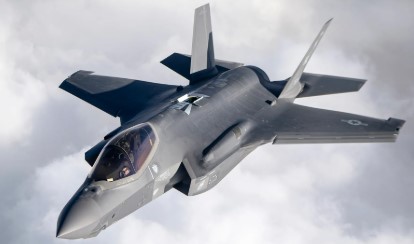More Advanced Fighter Jets Sent to the Middle East
The United States military has increased its presence in the Middle East by sending more of its most advanced fighter jets, the F-35s, to Jordan. These aircraft are part of a larger effort to stop ongoing attacks by the Houthis, a group in Yemen that has been targeting ships in the Red Sea. The Houthis receive support from Iran, making the situation even more complex.
The F-35 is one of the most advanced fighter jets in the world. It has stealth capabilities, which means it can avoid detection by enemy radar. It is also equipped with advanced sensors and weapons that allow it to attack both air and ground targets effectively. By sending more of these jets to the region, the US is strengthening its ability to conduct strikes against Houthi targets.
This deployment follows previous US efforts to contain conflicts in the Middle East. Earlier, the US had sent F-35s to the region when tensions escalated due to the situation in Gaza. At that time, the fighters were used to carry out airstrikes aimed at weakening the Houthis’ ability to attack ships.
Now, with the renewed wave of airstrikes, the US military has moved additional forces to the region, including extending the deployment of a major aircraft carrier group in the Red Sea. Another carrier group is also expected to arrive soon. In addition to fighter jets, other military aircraft, such as A-10 Warthogs and B-2 stealth bombers, have been positioned in strategic locations.
US Expands Airstrikes and Strengthens Military Presence
Over the past two weeks, the US military has carried out multiple airstrikes in Yemen, targeting Houthi command centers, missile launch sites, and weapons storage facilities. More than 100 sites have been hit in an attempt to disrupt the group’s ability to attack commercial shipping lanes. Despite these efforts, the Houthis have continued launching missiles and drones at ships passing through the Red Sea.
To increase its ability to respond, the US has also moved some of its high-tech air defense systems from other parts of the world. This includes Patriot missile batteries and the Terminal High Altitude Area Defense (THAAD) system, which are designed to protect US forces and allies from incoming missile threats. These defense systems were previously positioned in South Korea but have now been reassigned to the Middle East.
One of the most significant changes in the US military posture is the deployment of B-2 stealth bombers to Diego Garcia, a US military base in the Indian Ocean. The US Air Force has a total of 20 B-2 bombers, but not all of them are always ready for missions. With about half of its available B-2 fleet now in Diego Garcia, the US has positioned itself for continued operations in the region.
The Houthis have been one of the most resilient groups in the region, continuing their attacks despite heavy losses. Their actions began shortly after the conflict in Gaza escalated in late 2023. Since then, they have used missiles and drones to target ships traveling through the Red Sea, which is one of the world’s most important trade routes. The US and its allies have responded with a series of military strikes, but the Houthis have not stopped their attacks.
Strong Message to Iran and the Houthis
The US military buildup sends a strong signal to Iran, which has long supported the Houthis. The United States has made it clear that it will take military action if Iran or its allied groups threaten US forces or disrupt global trade routes. The deployment of advanced fighter jets, bombers, and air defense systems is part of this effort to deter further attacks.
At the same time, the US has warned the Houthis that their continued attacks will be met with more military strikes. The US has repeatedly stated that if the Houthis stop targeting commercial ships, the airstrikes will also stop. However, if the attacks continue, the US is prepared to take even stronger military action.
Despite the heavy bombardment of Houthi targets, commercial ships have not yet resumed their normal routes through the Red Sea. Many shipping companies have decided to reroute their vessels to avoid the risk of attacks. This has caused disruptions in global trade, as ships now have to take longer and more expensive routes.
The US military campaign in the region continues, with additional forces being deployed to maintain pressure on the Houthis. The situation remains tense, with both sides refusing to back down. The presence of more F-35s, aircraft carriers, and bombers in the region shows that the US is committed to keeping the Red Sea open for international trade while responding to ongoing threats.

